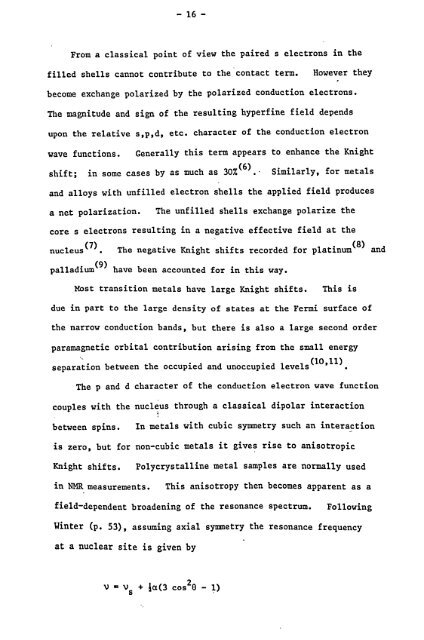NNR IN RAPIDLY ROTATED METALS By - Nottingham eTheses ...
NNR IN RAPIDLY ROTATED METALS By - Nottingham eTheses ...
NNR IN RAPIDLY ROTATED METALS By - Nottingham eTheses ...
Create successful ePaper yourself
Turn your PDF publications into a flip-book with our unique Google optimized e-Paper software.
- 16 -<br />
From a classical point of view the paired s electrons in the<br />
filled shells cannot contribute to the contact term. However they<br />
become exchange polarized by the polarized conduction electrons.<br />
The magnitude and sign of the resulting hyperfine field depends<br />
upon the relative s, p, d, etc. character of the conduction electron<br />
wave functions. Generally this term appears to enhance the Knight<br />
(6)<br />
shift; in some cases by as much as 30%. Similarly, for metals<br />
and alloys with unfilled electron shells the applied field produces<br />
a net polarization. The unfilled shells exchange polarize the<br />
core s electrons resulting in a negative effective field at the<br />
nucleus(l). The negative Knight shifts recorded for platinum(8) and<br />
palladium(9) have been accounted for in this way.<br />
Most transition metals have large Knight shifts. This is<br />
due in part to the large density of states at the Fermi surface of<br />
the narrow conduction bands, but there is also a large second order<br />
paramagnetic orbital contribution arising from the small energy<br />
separation between the occupied and unoccupied levelsl1)<br />
The p and d character of the conduction electron wave function<br />
couples with the nucleus through a classical dipolar interaction<br />
between spins. In metals with cubic symmetry such an interaction<br />
is zero, but for non-cubic metals it gives rise to anisotropic<br />
Knight shifts. Polycrystalline metal samples are normally used<br />
in NMR measurements. This anisotropy then becomes apparent as a<br />
field-dependent broadening of the resonance spectrum. Following<br />
Winter (p. 53), assuming axial symmetry the resonance frequency<br />
at a nuclear site is given by<br />
va vs + la(3 cos20 - 1)<br />
(10,

















